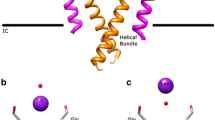Abstract
1. The aim of this study was to elucidate the effect of metabolic inhibition on the membrane potential and ion conductance of rat astrocytes. The metabolic inhibitors investigated were dinitrophenol (DNP), carbonyl cyanide p-trifluoromethoxyphenyl hydrazone (FCCP), cyanide, and oligomycin.
2. Primary cultures of astroglial cells from newborn rat cerebral cortex were cultivated for 13–20 days on chamber slides. The effect of metabolic inhibitors on the cellular ATP concentration was estimated from the decrease in peak chemiluminescence from the luciferin/luciferase reaction. The membrane potential and ion conductances were measured from whole-cell recordings with the patch-clamp technique.
3. After 2.0 min of incubation ATP decreased from the control level to 43%with cyanide (2 mM), 58% with DNP (1 mM), 47% with FCCP (1 μM), and 69% with oligomycin (10 μM).
4. Under normal conditions V was −74.4±1.0 mV. DNP and FCCP both caused a rapid and reversible depolarization equivalent to a shift in the I/V curve of 8.2±1.3 and 19.7±3.8 mV, respectively. DNP decreased the slope conductance (g) by 22.1% but FCCP had no significant effect on g. In contrast, neither oligomycin nor cyanide had any significant effect on the I/V curve.
5. Tetraethylammonium (TEA; 10 mM) depolarized the cells by 7.1±2.0 mV but had no significant effect on g. In the presence of TEA, DNP caused a depolarization of 52.8±3.5 mV and increased g by 45.5±9.6%. The action of FCCP was not affected by the presence of TEA.
6. Perfusion of the astrocytes with a Cl− free solution inhibited the action of DNP and FCCP. Thus the depolarization was only 4.2±1.5mV in DNP and 3.7±0.3 mV in FCCP, which were significantly smaller effects than in the presence of a high intracellular [Cl−].
7. Block of tentative KATP channels with tolbutamide (1 mM) or Cl− channels with Zn2+ (1 mM) did not inhibit the depolarization caused by DNP or FCCP.
8. In conclusion, DNP and FCCP have specific effects on the plasmalemma in rat astrocytes which may be due to opening of Cl− channels. This effect was not seen with cyanide or oligomycin and should be considered as a possible complication when DNP and FCCP are used for metabolic inhibition.
Similar content being viewed by others
REFERENCES
Anderson, S., Brismar, T., and Hansson, E. (1995). Effect of external K+,Ca2+,and Ba2+ on membrane potential and ionic conductance in rat astrocytes. Cell Mol. Neurobiol. 15(4):439–450.
Armstrong, C. M., and Binstock, L. (1965). Anomalous rectification in the squid giant axon injected with tetraethylammonium chloride. J. Gen. Physiol. 48:859.
Belousov, A. B., Godfraind, J.-M., and Krnjevic, K. (1995). Internal Ca2+ stores involved in anoxic responses of rat hippocampal neurons. J. Physiol. 486:547–556.
Brismar, T., and Collins, V. P. (1993). Effect of external cation concentration and metabolic inhibitors on membrane potential of human glial cells. J. Physiol. 460:365–383.
Brismar, T., Anderson, S., and Collins, V. P. (1995). Mechanism of high K+ and Tl+ uptake in cultured human glioma cells. Cell. Mol. Neurobiol. 15(3):351–360.
Champe, P. C., and Harvey, R. A. (1994). Bioenergetics and oxidative phosphorylation. In Biochemistry, Lippincott, Philadelphia, pp. 102–109.
Duchen, M. R. (1990). Effects of metabolic inhibition on the membrane properties of isolated mouse primary sensory neurones. J. Physiol. 424:387–409.
Fujiwara, N., Higashi, H., Shimoji, K., and Yoshimura, M. (1987). Effects of hypoxia on rat hippocampal neurones in vitro. J. Physiol. 384:131–151.
Godfraind, J. M., Kawamura, H., Krnjevic, K., and Pumain, R. (1971). Actions of dinitrophenol and some other metabolic inhibitors on cortical neurones. J. Physiol. 215:199–222.
Hagiwara, S., and Saito, N. (1959). Voltage-current relations in nerve cell membrane of Onchidium verruculatum. J. Physiol. 148:161–179.
Hansen, A. J., Hounsgaard, J., and Jahnsen, H. (1982). Anoxia increases potassium conductance in hippocampal nerve cells. Acta Physiol. Scand. 115:301–310.
Hansson, E. (1988). Astroglia from defined brain regions as studied with primary cultures. Prog. Neurobiol. 30:369–397.
Hansson, E., and Rönnbäck, L. (1989). Primary cultures of astroglia and neurons from different brain regions. In A Dissection and Tissue Culture Manual of the Nervous System (A. Shahar, Ed), Alan R. Liss, New York, pp. 92–104.
Hyllienmark, L., and Brismar, T. (1996). Effect of metabolic inhibition on K+ channels in pyramidal cells of the hippocampal CA1 region in rat brain slices. J. Physiology 496:155–164.
Kanai, Y., Smith, C. P., and Hediger, M. A. (1993). The elusive transporters with a high affinity for glutamate. Trends Neurosci. 16(9):365–370.
Leblond, J., and Krnjevic, K. (1989). Hypoxic changes in hippocampal neurons. J. Neurophysiol. 62:1–14.
Marty, A., and Neher, E. (1983). Tight-seal whole cell recording. In Single Channel Recording (B. Sakmann and E. Neher, Eds.), Plenum Press, New York, pp. 107–122.
Olson, M. S. (1993). Bioenergetics and oxidative metabolism. In Textbook of Biochemistry with Clinical Correlations (T. M. Devlin, Ed.), Wiley-Liss, New York, pp. 237–287.
Stanfield, P. R. (1970). The differential effects of tetraethylammonium and zinc ions on the resting conductance of frog skeletal muscle. J. Physiol. 209:231–256.
Sturgess, N. C., Cook, D. L., Ashford, M. L., and Hales, C. N. (1985). The sulphonylurea receptor may be an ATP-sensitive potassium channel. Lancet 2:474–475.
Author information
Authors and Affiliations
Rights and permissions
About this article
Cite this article
Juthberg, S.K.A., Brismar, T. Effect of Metabolic Inhibitors on Membrane Potential and Ion Conductance of Rat Astrocytes. Cell Mol Neurobiol 17, 367–377 (1997). https://doi.org/10.1023/A:1026331226241
Issue Date:
DOI: https://doi.org/10.1023/A:1026331226241




